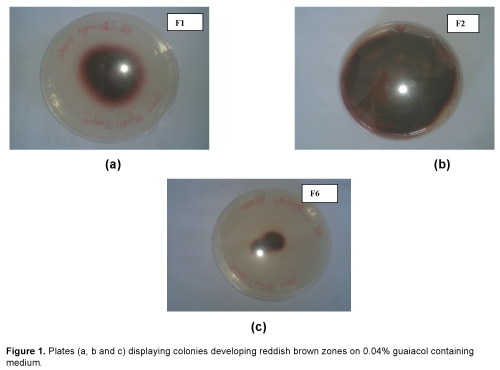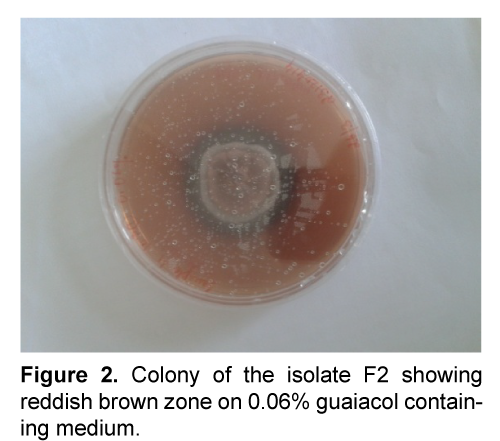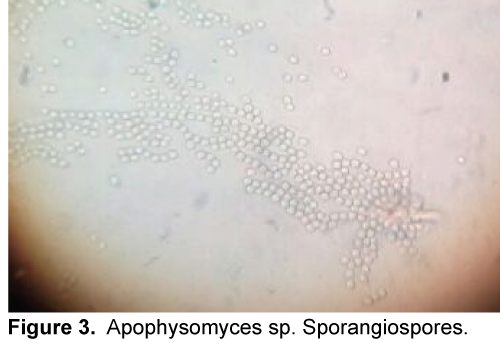Screening of Laccase producing fungi from soil samples - An In Vitro Study
Ram Kumar Pundir, Viraj Krishna Mishra, Satish Rana and Megha Lakhani
Ram Kumar Pundir*, Viraj Krishna Mishra, Satish Rana and Megha Lakhani
Department of Biotechnology Engineering, Ambala College of Engineering and Applied Research (ACE), Devsthali, PO Sambhalkha, Ambala-133101, Haryana, India.
- Corresponding Author.
- Tel: 0171 282 2001; Email: drramkpundir@gmail.com
Received Date: March 30, 2016; Accepted Date: April 16, 2016; Published Date: April 22, 2016
Citation: Pundir RK, Mishra VK, Rana S, et al. Screening of laccase producing fungi from soil samples: An In Vitro Study. Electronic J Biol, 12:3
Abstract
In present study, 37s fungal strains were isolated on PDA plate containing the 0.02% guaiacol. Out of these 37 isolates, only eight fungal isolates showed reddish brown zones on the medium. The most potent fungal strain for laccase production was screened on 0.06% guaiacol containing PDA medium. On the basis of cultural characteristics, morphological and microscopic sporulating structure it was determined that the isolated fungus belonged to the Apophysomyces sp. This novel laccase producing fungal isolate can be used for large scale production of laccase and in the treatment of various industrial effluents.
Keywords
Apophysomyces; Laccase; Guaiacol; Isolation; Fungi; Characterization; Purification
Introduction
Laccase (EC1.10.3.2) is the member of the polyphenoloxidases enzyme family and it is a multicopper- containing enzyme. Laccase reduces molecular oxygen to water and oxidize substrates (diphenols, methoxy-substituted monophenols, aromatic and aliphatic amines) into free radicals [1-3]. The reducing substrate loses an electron and usually forms an unstable free radical which may undergo further chemical changes by laccase-catalysed oxidation or nonenzymatic reactions including, hydration, disproportionation and polymerization [4,5]. Laccase was first detected in the sap of the Japanese laquer tree Rhus vernicifera by Yoshida in 1883. Presence of Laccase enzymes have been widely reported in fungi, bacteria, plants and insects. Among Ascomyceteous, Deuteromyceteous and Basidiomyceteous fungi, white rot Basidiomyceteous fungi have been widely studied for laccase production and characterization [6]. White rot Basidiomyceteous fungi mostly secrete laccase and other oxidative enzyme such as peroxidise which depolymerise lignin [4,7].
Different isoenzymes of fungal laccases have been identified. Most of the isoenzymes are monomers of protein [8-10]. Fungal laccase are mainly glycoproteins with 10-20 % carbohydrate providing high stability to fungal laccase enzyme at average molecular mass of 60-70 kDa [11]. In the present study, the production of laccase at the late stage of cultivation. Our finding similar the finding of Periasamy and Palvannan [12], also studied that the secreted laccase enzyme is not a primary metabolite and it was a secondary metabolite.
Laccase have been widely studied in degradation of xenobiotics, decoulrization of dyes, depolymerisation of lignin, pigment production, pulp and paper bleaching, biosensor and biofuel cells, based on laccase, have been developed by utilizing its oxidative property and broad range of substrate specificity, laccases have been also used to prevent undesired changes in food and beverages to increase the shelf life of food and beverage products [13,14]. Keeping in view the above justification, the aim of present study was to isolate and screen laccase producing fungi from soil samples.
2. Materials and Methods
2.1 Isolation of laccase producing fungi
Soil samples and tree bark scrapings were collected from near Ambala College of Engineering and Applied Research, Ambala, (Haryana, India) in sterile plastic bags and serially diluted. Serial dilutions of 10 samples were prepared till 10-5 dilutions. 100 μl aliquot from the dilution 10-3, 10-4 and 10-5 were taken and spread on PDA plates. Samples were spread on potato dextraose agar medium that were supplemented with 0.02% guaiacol [15]. The plates were incubated aerobically at 25°C - 27°C for 5 days for fungal growth. Fungal cultures were purified by point inoculation/streaking and disc transfer method. Pure cultures were maintained on PDA slants at 40ºC for further study. The medium was sterilized by using autoclave at 121°C at 15 psi for 15 minutes. The culture was inoculated into the medium and incubated at 25°C - 27°C for 5 days.
2.2 Selection of potent fungal strain and identification
The most potent laccase producing fungal strain was screened according to its capability of strain to grow on PDA medium supplemented with guaicaol. Guaiacol degrading fungal strain showed considerable growth and redish brown zone on medium supplemented with different concentrations of guaiacol i.e. 0.02%, 0.04% and 0.06%. Potent fungus was identified on the basis of its morphological characteristics i.e. hyphae, sporulating structure, sporocarp, arrangement of conidia and cultural characteristics i.e. colony colour, front and bottom view and texture [16-18].
3. Results and Discussion
A total of 37 different fungal colonies was observed and then screened for laccase production. The white rot fungus is the most common laccase producers among all fungi [19]. All fungal isolates were screened for laccase production on PDA medium supplemented with 0.02% guaiacol as substrate. Eight fungal isolates developed reddish brown zones in the medium due to oxidative polymerization of guaiacol, which marked the presence of laccase and were marked as F1 to F8. Guaiacol concentration was increased from 0.02% to 0.04% and 0.06% on different PDA plates. F1, F2 and F6 fungal strains developed reddish brown zones in the medium containing 0.04% guaiacol (Figure 1). Further, these 3 fungal strains were screened on 0.06% guaiacol out of which only F2 developed reddish brown zone in the medium (Figure 2).
In the present study, F2 fungal isolate identified as Apophysomyces sp. (having features such as white colour colony initially and then turned creamy white to buff with age, filamentous, contain sporangiophore bearing sporangium contains sporangiospore (Figure 3) was found to be most potent laccase producing fungus (having ability to degrade guaiacol at high concentration i.e. 0.02% to 0.04% and 0.06%), out of the 37 fungal isolates. Apophysomyces is a genus of filamentous fungi that are commonly found in soil and decaying vegetation. Species normally grow in tropical to subtropical regions. The genus Apophysomyces historically was mono-specific, containing only the type species Apophysomyces elegans [20]. In 2010, three new species were described: A. variabilis, A. trapeziformis, and A. ossiformis [21]. As per our knowledge and literature search revealed that this is the first report on laccase production by the genus Apophysomyces. In the present study, the production of laccase at the late stage of cultivation. Our finding similar the finding of that also studied that the secreted enzyme is not a primary metabolite and it was a secondary metabolite [22].
Similar results have been also reported by Viswanath et al. [23] using 0.02% guaiacol as an indicator for laccase producing fungal strains i.e. Stereum ostrea and Phanerochaete chrysosporium fungi from different samples.. Thorn et al. [24] screened laccase producing Saprophytic Basidiomycetes from Soil. This produced bright red zone beneath their colonies caused by the quinone oxidation product of guaiacol. Kiiskinen et al. [25] had also isolated eight microorganism using guaiacol as substrate for laccase enzyme. Zhang et al. [26] studies on effects of Inoculation of Arbuscular Mycorrhizal Fungus and Apophysomyces spartina on P-uptake of Castor Oil Plant (Ricinus communis L.) and Rhizosphere Soil Enzyme Activities under Salt Stress. This strain showed higher enzymatic activity at solid state condition than submerged condition [27]. Laccase producing fungus, Pleurotus ostreatus IMI 395545 was isolated from Kolli hills, Namakkal Dt., Tamil Nadu, India. This fungal strain was further used in decolorization of dyes like Poly R-478 and RBBR [12]. Ahmed and Siddiqui [28] also isolated and Screened laccase producing Trichoderma species from different environmental samples and concluded that Out of 29 isolates belong to 7 species of Trichoderma were screened as laccase producers, based on decolorization of guaiacol Trichoderma harzianum isolated from industrial wastewater was found to be best potential laccase producing fungus while Trichoderma viridae showed the least growth.
4. Conclusion
The present research work is first report on fungal laccase from the genus, Apophysomyces sp. Some species of Apophysomyces are pathogenic too, it need to be ascertain that isolated fungal strain is pathogenic or non-pathogenic. More study is needed to characterize and purify this fungal laccase to explore its application.
5. Acknowledgements
The authors are very grateful to Management of Ambala College of Engineering and Applied Research, Devsthali Ambala (Haryana) for providing the lab facilities and also encouraging us to write this manuscript.
References
- Munusamy U, Sabaratnam V, Muniandy S, et al. (2008). Biodegradation of polycyclic aromatic hydrocarbons by laccase of Pycnoporus sanguineus and toxicity evaluation of treated PAH. Biotechnology. 7: 669-677.
- Kudanga T, Nyanhongob GS, Guebitzb GM, et al. (2011). Potential applications of m laccase-mediated coupling and grafting reactions: A review. Enzyme Microb Technol. 48: 195-208.
- Elsayed MA, Hassan MM, Elshafei AM, et al. (2012). Optimization of Cultural and Nutritional Parameters for the Production of Laccase by Pleurotus ostreatus ARC280. British Biotechnology Journal 2: 115-132.
- Thurston CF. (1994). The structure and function of fungal laccases. Microbiol. 140: 19-26.
- Kiiskinen LL, Kruus K, Bailey M, et al. (2004 a). Expression of Melanocarpus albomyces laccase in Trichoderma reesei and characterization of the purified enzyme. Microbiol.150: 3065-3074.
- Assavanig A, Amornkitticharoen B, Ekpaisal N, et al. (1992). Isolation, characterization and function of laccase from Trichoderma. Applied Microbiology and Biotechnology. 38: 198-202.
- Baldrian P. (2006). Fungal laccases - occurrence and properties. FEMS Microbiol. Rev. 30: 215-242.
- Yaver DS, Xu F, Golightly EJ, et al. (1996). Purification, characterization, molecular cloning, and expression of two laccase genes from the white rot basidiomycete Trametes villosa. Appl Environ Microbiol. 62: 834-841.
- Marques De Souza CG, Peralta RM. (2003). Purification and characterization of the main laccase produced by the white-rot fungus Pleurotus pulmonarius on wheat bran solid state medium. J Basic Microbiol. 43: 278-286.
- Kunamneni A, Ballesteros A, Plou FJ, et al. (2007). Fungal laccase - a versatile enzyme for biotechnological applications. Communicating Current Research and Educational Topics and Trends in: Méndez-Vilas A (ed.) Applied Microbiology Formatex. 1: 233-245.
- Gianfreda L, Xu F, Bollag JM. (1999). Laccases: a useful group of oxidoreductive enzymes. Bioremed J.3: 1-25.
- Periasamy R, Palvannan T. (2013). Optimization of laccase production by Pleurotus ostreatus IMI 395545 using the Taguchi DOE methodology. J. Basic Microbiol. 50: 548-556.
- Jhadav A, Vamsi KK, Khairnar Y, et al. (2009). Optimization of production and partial purification of laccase by Phanerochaete chrysosporium using submerged fermentation. Int. J. Microbiol. Res. 1: 9-12.
- Viswanath B, Bandi R, Avilala J, et al. (2014). Fungal Laccases and Their Applications in Bioremediation. Enzyme Research. 1-22.
- Coll PM, Abalos JMF, Villanueva JR, et al. (1993). Purification and characterization Phenoloxidase (Laccase) from the Lignin-Degrading Basidiomycete PM1 (CECT 2971). Appl. Environ. Microbiol. 59: 2607-2613.
- Ellis MB, Ellis PJ. (1997). Microfungi on land plants, An identification Handbook. New England Edition, Hardback.
- Barnett HL, Hunter BB. (1998). Illustrated genera of imperfect fungi (4th edn.) APS Press, St. Paul. Minnesota, USA.
- Gilman JC. (2001). A manual of soil fungi, 2nd Indian Edition. Biotech Book Pvt. Ltd., India.
- Singh N, Abraham J. (2013). Isolation of laccase producing fungus from compost soil and partial characterization of laccase. Advances in Applied Science Research. 4: 91-98.
- Collier L, Balows A, Sussman M. (1998). Topley & Wilson's Microbiology and Microbial Infections (9th edn.). vol. 4.
- Alvarez, Eduardo, Stchigel, et al. (2010). "Molecular phylogenetic diversity of the emerging mucoralean fungus Apophysomyces: Proposal of three new species". Revista Iberoamericana de Micología 27: 80-89.
- Desai SS, Tennali GB, Channur N, et al. (2011). Isolation of laccase producing fungi and partial characterization of laccase. Biotechnol. Bioinf. Bioeng. 1: 543-549.
- Viswanath B, Chandra MS, Pallavi Het al. (2008). Screening and assessment of laccase producing fungi isolated from different environmental samples. African Journal of Biotechnology. 7: 1129-1133.
- Thorn RG, Reddy CA, Harris D et al. (1996). Isolation of Saprophytic Basidiomycetes from Soil. Appl. Environ. Microbiol. 62: 4288-4292.
- Kiiskinen LL, Kruus K. (2004 b). Screening for novel laccase-producing microbes. Journal of Applied Microbiology. 97: 640-646.
- Zhang H, Qin P, Zhang W. (2014). Studies on effects of inoculation of arbuscular mycorrhizal fungus and Apophysomyces spartina on P-uptake of Castor Oil Plant (Ricinus communis L.) and Rhizosphere Soil enzyme activities under salt stress. Agricultural Science and Technology. 4: 659-664.
- Desai SS, Nityananda C. (2011). Microbial Laccases and their applications: A review. Asian Journal of Biotechnology. 2: 98-124.
- Ahmed S, Siddiqui M. (2015). Screening and assessment of laccase producing Trichoderma species isolated from different environmental samples. J Ani Plant Sci. 25: 606-610.

Open Access Journals
- Aquaculture & Veterinary Science
- Chemistry & Chemical Sciences
- Clinical Sciences
- Engineering
- General Science
- Genetics & Molecular Biology
- Health Care & Nursing
- Immunology & Microbiology
- Materials Science
- Mathematics & Physics
- Medical Sciences
- Neurology & Psychiatry
- Oncology & Cancer Science
- Pharmaceutical Sciences



